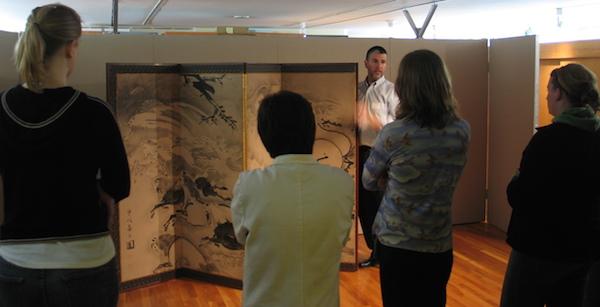LACMA has hundreds of screens, scrolls, and albums in its Chinese, Japanese, and Korean collections. The handling and treatment of these objects are highly specialized and few institutions in the United States are equipped to deal with East Asian paintings. So we were thrilled to learn from our colleagues at the Freer and Sackler Galleries through a daylong session on the safe handling of screens and scrolls, as well as a two-day workshop on minor repairs.
The Hirayama Program at the Freer and Sackler Galleries provides information and training to help increase awareness and enhance the care of East Asian paintings in American museum collections. Supervisory conservator of the Freer and Sackler Galleries Andrew Hare developed lectures and workshops for investigating traditional methods and materials, creating a forum for American museum staff to exchange specialized knowledge and advance technical research about East Asian painting conservation.
Andrew’s workshop included handling sessions on folding screen, scrolls, hand scrolls, and albums. Folding screens consist of hinged paper panels that can be safely handled by holding the outer wooden edges of the frame. Opening a folding screen requires a specific sequence combined with a delicate touch and keen spatial awareness, as improper handling can cause damage to the hinges and punctures to the hollow screens. Hand scrolls are paintings that have been mounted into a scroll format and require careful unrolling for viewing.
After a fruitful session on handling such objects, we turned our attention to the numerous screens and scrolls in LACMA's collection that need minor repair. These repairs do not require a professional mounter but still necessitate a very particular knowledge and training.
In order to address this, LACMA hosted a two-day training session with Jiro Ueda, the East Asian paintings conservator at Freer and Sackler. To promote collaboration and build relationships within the museum community, we also invited conservators from institutions with large holdings of Asian paintings, such as the Museum of Fine Arts, Houston and the Asian Art Museum in San Francisco.
The training began by replacing the decorative cloth cord on a hanging scroll. This cord is used to mount the scroll onto the wall and is frequently damaged after many years of use. Jiro brought mock-ups so each conservator could practice the proper knotting of the cord and installation of the traditional metal hardware. After the hardware was placed on the upper rod, traditional Japanese cords were knotted and threaded through the metal clips.
Hanging scrolls are unrolled for viewing and then rerolled and returned to their custom boxes for storage. This handling often causes linear creasing in the mount materials. To repair this, the creases are reinforced with thin strips of Japanese paper attached to the reverse of the mount with wheat starch paste. The width of the mending strips is measured in bu and each strip needs to be cut exactly to the correct width to give the proper support and look of a high-quality mend. Jiro demonstrated how these strips were to be cut as well as how they were pasted and placed to support the creases.
Often knobs on scrolls need to be replaced.
The end of the rod is adjusted to accommodate the inner diameter of the new knob using Japanese tissue. The new knob is attached to the rod with thick glue.
The complex construction of a folding screen and the manner in which it is handled and displayed can cause structural damage over time. This is most often manifested as broken hinges and punctures in the sides of the paper-covered lattice of standing screens. Jiro is seen here water-tearing Japanese paper for the hinge repair. The paper is first scored with a bone folder, followed by brushing with water. The paper is then torn along the crease by hand.
Jiro mends a broken hinge with a Japanese paper insert.
Punctures are examined to determine where to insert a Japanese paper mend.
A medium-weight Japanese paper is selected, cut, and contoured to fit underneath the puncture. Once that is in position, the lifted areas are reattached with wheat starch paste. As the paste dries the paper pulls tight across the mend and the puncture becomes flat and secure.
After the training, numerous treatments were performed on objects in LACMA’s collection, including hinge repair, knob reattachment, and hanging cord replacement. This was the first in a series of workshops we expect to host from the Freer and Sackler to build a greater understanding for the care of LACMA’s Asian collections, and we’ll be sure to share the results of future sessions on Unframed!



